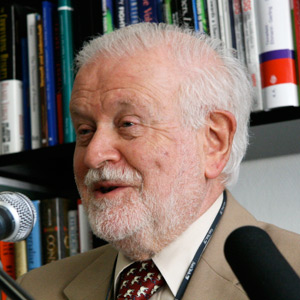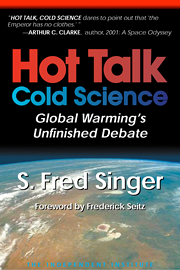Maybe you’ve heard or read somewhere that all kinds of terrible disasters will happen if the (global mean surface) temperature rises just 2⁰C above the pre-industrial level; according to some datasets, we are already more than halfway there. Further, activists want to lower the threshold to 1.5⁰C —thus advancing the date of the “apocalypse.”
Note, however, that these same activists never bother to define “mean temperature” or tell you how to measure it—if indeed that makes sense. Temperatures vary not only geographically, mainly with latitude and altitude, but also with season, time of day, and weather conditions.
Have you ever wondered where the 2⁰C number comes from? Does it sound like the Y2K scare all over again? Well, let me tell you, because I have something to do with provoking its original publication.
In 1995, I published an article in Eos, the journal that goes to every member of the American Geophysical Union, a professional society of which I am a life-member and an elected Fellow. I claimed there that we couldn’t see any evidence for a significant human contribution to global warming. Naturally, this provoked some immediate responses—which I commented on in turn.
One response came from two Swedish scientists, Henning Rodhe and Christian Azar of Stockholm University. This was the first time I saw this magic 2⁰C value. Of course, they gave a reference for this number, which turned out to be a publication in the Swedish journal Tellus -- by the same authors. In other words, it was a self-reference—or a circular argument if you prefer. It may even have been self-refereed; I don’t know. Anyway, there is nothing to indicate that anything drastic will happen at the 2⁰C limit. None of the climate models suggest any particular disaster; there will be no runaway warming; and climate warming will not become irreversible.
So, I wondered, what is the significance of this 2⁰C number—and I concluded that it is the “Goldilocks” choice. It turns out, 2⁰C is “just right”—not too small, not too large.
Consider for a moment what would have happened if they had given a number like 0.5⁰C. People would have shrugged their shoulders and said, “Oh, we’ve already passed that threshold, and nothing has happened. So why worry?”
Or suppose they had chosen 5⁰C. People would have shrugged their shoulders and said “Oh, we’ll never reach that temperature certainly not in this century or the next.”
So now you see why 2⁰C was just the right choice. It is coupled, of course, with the prediction of some dreadful happenings, together with the recurring admonition that the apocalypse can be avoided if we only stopped using fossil fuels to produce energy.
Elsewhere, in a 1997 article in Science, the same two authors adopt a more nuanced stance:
“The United Nations Framework Convention on Climate Change calls for a “stabilization of greenhouse gas concentrations in the atmosphere at a level that would prevent dangerous anthropogenic interference with the climate system.” However, the required level is still unclear. There are two main reasons. First, the climatological, ecological, and social impacts associated with any given level of atmospheric CO2 concentration are still uncertain; the equilibrium impact on global temperature of a doubling of the CO2 concentration alone is estimated by the Intergovernmental Panel on Climate Change (IPCC) to have an uncertainty range of (at least) 1.5° to 4.5°C. Second, even if impacts were known with 100% certainty, the concept of dangerous interference is ultimately a question of value judgments that can only be settled in the political arena. [emphasis added]
Given the present scientific uncertainties, no firm conclusions can be drawn, but interesting insights can be obtained by comparing expected changes in equilibrium temperature obtained from a simple model with some measures of the natural variability in global temperature. ... A further comparison can be made with the change in global mean temperature of about 5°C that is estimated to have occurred during the past glacial cycle.
If the climate system is sensitive to CO2 increases in the IPCC’s upper range, then a CO2 concentration of only 550 ppmv will be sufficient to yield a change in average global temperature of a magnitude approaching that which occurs during the transition to an ice age. It appears that to keep the changes in global temperature within the range of natural fluctuations during the past millennium, the climate sensitivity has to be low and the atmospheric CO2 concentration has to be stabilized at around 350 ppmv. [NB: It is now, 2016, >400 ppm]
Perhaps to balance this story, I should tell you about another myth—one believed by only few “Climate Deniers.” Some of them argue that the human contribution to CO2 levels in the atmosphere is only 3% to what is already a minute concentration of about 400 parts per million.
There are also two additional myths that are sometimes put forward. One of them is that the observed increase in CO2 is a fraud or some sort of conspiracy. And that in any case, the observed increase in CO2, if taken to be real, is due to warming of the ocean. Wrong again.
A side argument, also wrong, that the concentration of CO2 is just too small to have any effect on the atmosphere. It is after all just a trace gas; so how can it possibly be the cause of a real change in climate. Well, it turns out that CO2 is an extremely effective absorber of Infrared Heat Radiation and therefore a true greenhouse gas.
But to finish this story, I go back to the major error of the UN climate panel, the Intergovernmental Panel on Climate Change (IPCC). They have been claiming in all their 5 major reports that CO2 increases are the cause of warming. I am of the opinion, and have tried to back it up with publications, that these arguments don’t hold water and that their evidence does not exist.









